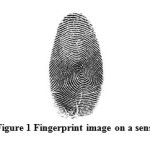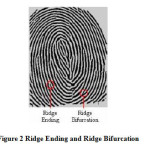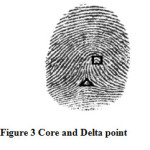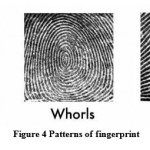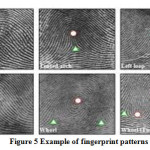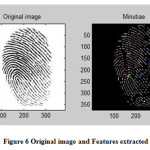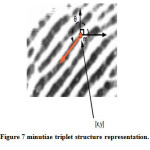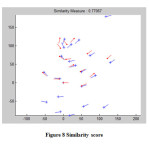Improve Fingerprint Recognition Using both Minutiae Based and Pattern Based Method
Avani Patel, Prof. Vikram Agrawal, Prof. Vatsal H. Shah
B.V.M. Engineering College, GTU, V.V. Nagar-388120, India
Article Publishing History
Article Received on :
Article Accepted on :
Article Published : 28 Jul 2014
Article Metrics
ABSTRACT:
Fingerprint recognition is one of the biometric techniques that are used for identification purpose. A number of recognition methods have been used to perform fingerprint matching. The Straightforward matching between the fingerprint pattern to be identified and many already known patterns would not serve well due to its high sensitivity to errors. This paper presents a combination of pattern based and minutiae based method. Here first core point, delta points and minutiae features are found and based on that matching is to be done. Here poor quality of fingerprint images are also enhanced using wiener low pass filter.
KEYWORDS:
fingerprint, pattern, minutiae features, low pass filter
Copy the following to cite this article:
Patel A, Agrawal V, Shah V. H. Improve Fingerprint Recognition Using both Minutiae Based and Pattern Based Method. Orient. J. Comp. Sci. and Technol;7(2)
|
Copy the following to cite this URL:
Patel A, Agrawal V, Shah V. H. Improve Fingerprint Recognition Using both Minutiae Based and Pattern Based Method. Orient. J. Comp. Sci. and Technol;7(2). Available from: http://www.computerscijournal.org/?p=1069
|
Introduction
The fingerprints have been used as a mean for identifying individual for a longtime because the finger prints are unique and stay unchanged throughout an individual life time. The chance of two people—even identical twins—having the same finger print is probably less than one in a billion. Finger print comparison is the most widely used method of biometric authentication and the most cost effective. Currently there are about 200 million FBI cards (10 fingerprints per cards)stored in cabinets that would fill an area of one acre.
The manual effort of identifying and maintaining such a system is very cumbersome, time consuming and expensive as the number of fingerprint records grows at a rate from 30 to 50 thousands cards per day[1].
What is a finger print?
A fingerprintis the feature pattern of one finger (Figure 1).It is an impression of the friction ridges and furrows on all parts of a finger. The seridges andfurrows present good similarities in each smalllocal window, like parallelism and average width. [2]
There are two basic methods of fingerprint recognition: –
- Minutiae based method
- Pattern based method.
Minutiae basedmethod
Most of the finger-scan technologie sare based on Minutiae. Minutia-based techniquesre present the finger print by itslocalfeatures,like termination sand bifurcations.This approach has been intensively studied,also is the backbone of the current available finger print recognition products.Figure 2 shows the termination and bifurcation points.
Pattern based method
Pattern based algorithm scompare the basic finger print patterns (arch,whorl,and loop)between a previously stored template and a candidate fingerprint.This require s that the images bealigned in the same orientation.Todo this, the algorithm finds a central point in the finger print image and centers on that.
Finger print classification
The analysis of finger prints for matchin gpurp oses generally requires the comparison of several features of the print pattern. These include patterns, which are aggregate character is ticsofridges, and minuti a points,which are unique features found within the patterns.Individual s generally have a mixture of pattern type son their finger tips,with some correlation between the left and right hands.While the loop pattern is the most common pattern, classification of individuals by assigninga pattern type to each of the ten finger sin an ordered fashion,serves as a first line of differentiation,however,no such classification is likely to be unique. [3] The three basic finger print classification sare the loop,arch,and whorl. See figure4
- Loop
Aloo pisa pattern where the ridge senter from one side of a finger,form a curve, and ten dtoexit from the same side they enter.A single delta type divergence must be present in front of the looping ridges. There are two type sofloops: Right loop and Left loop.
- Left Loop : Circular pattern that is finger print lines access from one direction then back from the same direction after a rotation around.To the lefisLeft Loop. Thereis acoreand a delta at the lower left.
- Right Loop : To the right is Right Loop.The reisa Core and a deltaat the lower right.
2) Arch
An archisa pattern where ther idge senter from one side of the finger,rise in the center form inganarc, and the nexit the other side of the finger. There are two types of Arch: Plain Arch and Tented Arch.
- Plain Arch:Ridges enter wave or rise and exit smoothly.
- Tented Arch : Ridges rise in the center,thrust up ward to give an appearance similar to tent.Insideangle is smaller than 90 degrees
3) Whorl
At leasttwodeltatypedivergencesarepresentwithloopingridgesinfrontof each. There are fourtypes of Whorl: PlainWhorland DoubleLoop
- Plain Whorl: One or more ridges form a complete revolution around the center with two deltas.
- Double Loop : Two separate loops are present which some times surround each other.
Proposed work
There are two basic steps : Pre- processing and Post – processing.
Pre- processing consist of
1) Finger print Image Reading:
In this step, the finger print image is loaded by using the Matlab built-in function
2) RGB to Gray Image
Raw data of finger print image obtained is in the R G B format.The finger print image in the R G B format is then changed in to gray scale image so that image processing can be executed on the image.
3) Image Enhancement
Some times, the image obtained does not have good quality and thus the purpose of enhancement is to process the image obtained so as to make it clearer by improving perception or interpretability and hence the accuracy of matching will be increased. By enhancing the image, the quality of image can be upgraded and thus the contrast between ridges and valleys can be increased. Here histogram equalization is done followed by wiener low pass filter is used.
- Histogram Equalization: To increase the contrast of the captured image histogram equalization is necessary. The histogram of a digital image with gray levels in the range (0, L-1) is a discrete function defined by
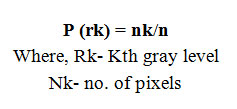
- Weiner low pass filter: To smooth the high frequency regions of the print low pass filtering is necessary. For this purpose Weiner Lowpass Filtering is used.
4) Binarization: Image binarization is one of the image pre-processing stage with the purpose of converting a gray scale image into a binary image. Gray scale image has 256 gray levels (0-255) while a binary image consists of 0-1 (black and white) where 0 is for ridge and 1 is for furrow. Binarization is an important process as binary image is needed for the thinning process instead of gray scale image

Post-processing involves:
1) Thinning
It is the process done on binary image by reducing all lines of fingerprint into thickness of one single pixel. After thinning process, the fingerprint image is in single pixel width where each ridge is thinned to center pixel and there are no discontinuities. This is done using the MATLAB’s built in morphological thinning function.
bwmorph(binary Image,’thin’,Inf)
2) Termination and Bifurcation Extraction
Then the thinned binarized image has each pixel to be analyzed in order to find the minutiae location. This is done by having a 3 x 3 window is traversed in anti clock wise direction to find a crossing number(cn).

ifcn = 3 then that point is a bifurcation,if cn = 1 then mark it as termination,if cn = 5 it is a core point and if cn > 5 it is a delta point.
3) Removal of false minutiae
Invalid end points,branch points and pores are removed from the templates by comparing it with the original image. Thus reducing the error rate.
Fingerprint matching
Similarity score
We produce geometric constraints for the discovery of minutiae matching pairs, including geometric distance:

Or to account for scale difference (i.e. if we are comparing images collected from different resolution scanners
Formula

and minutiae angle differenc

The geometric tolerance rδ is in place to account for distortion that may occur, where as is the tolerance for angular differences that may arise due to orientation estimations from the ridge orientation images, mAi, mBi ,are the minutiae pairs.
Once genuine minutiae pairs are produced, a metric of similarity, usually called the similarity score, can then be calculated. The similarity score must accurately describe how similar two fingerprints are, taking in to account all of the relevant information obtained from earlier stages such as number of genuine minutiae pairs and how similar each pair is. One similarity score given in Liang & Asa no (2006)is defined as

where nmatchis the number of matching minutiae pairs,and nA, nB are the number of minutiae in the overlapped regions of the template and test fingerprints following registration.
Conclusion
In this paper, we have proposed a reliable method for feature extraction from fingerprint images.The main contribution of the of this paper are (i) extra types of pattern (ii) finding minutiae points (iii) finger print verification (iv) fingerprint matching. In the pattern based matching the core point and delta points are detected.But problem occurs when only partial print is available. Socore point as well as delta could not be found so matching is not possible. Where as in minutiae based only minutia features are to be extracted and it could be found also in partial prints and using these features test image is matched with those stored in the template.
Future work: Thus the combination of minutiae based and pattern based could be used to obtain accurate result when only partial print is available. But combining these two methods is time consuming as larger templates are to be stored. Thus work can be done to make the technique time efficient. As well as more work can be done to execute the matching procedure faster.
References
- Sangram Bana and Dr. Davinder Kaur „Fingerprint Recognition using image segmentation‟, feb-2011.
- Dr. H.B.kehre, Dr. Tanuja Sarade, Rekha Vig„ Fingerprint identification using sectorized cepstrum‟, oct-2010.
- Sarnali Basak, Md. Imdadul Islam and M. R. Amin „Detection of a virtual core point of a fingerprint: A new approach‟ ,may-2012.
- Divyakant T. Meva, C. K. Kumbharana and Amit D. Kothari „The study of adoption of neural network in fingerprint recognition‟, feb-2012.
- H B Kekre and V A Bharadi „Fingerprint core point detection algorithm using oriental field based multiple feature‟,oct- 2010.
- Joshua Abraham, Paul Kwan and Junbin Gao “Fingerprint Matching using A Hybrid Shape and Orientation Descriptor”,oct-2010
- Liu Wei , “Fingerprint Classification Using Singularities Detection” ,sep-2012.
- Jianjiang Feng, “Combining minutiae descriptors for fingerprintmatching”, Mar-2007.
- Navrit Kaur Johal, Prof. Amit Kamra, “A Novel Method for Fingerprint Core Point Detection” International Journal of Scientific & Engineering Research Volume 2, Issue 4, April-2011.
- Mrs. Hemlata Patel, Pallavi Asrodia, “Fingerprint Matching Using Two Methods”, (IJERA) Vol. 2, Issue 3, May-Jun 2012, pp.857-860 . .
- Jie Zhou, Senior Member, IEEE, Fanglin Chen, and Jinwei Gu, Student Member, IEEE ,“A Novel Algorithm for Detecting Singular Points from Fingerprint Images”, IEEE, vol. 31, no. 7,july-2009.
- Ajay Jangra, Vedpal Singh, Priyanka, “Fingerprint-Classification based Quick Identification Algorithm”, july-2011.
- Monowar Hussain Bhuyan, Sarat Saharia, and Dhruba Kr Bhattacharyya , “An Effective Method for Fingerprint Classification”, International Arab Journal of e- Technology, Vol. 1, No. 3, January 2010.
- Han zhike, Lu Minyuan , “Improved Pattern-based Fingerprint Image Preprocessing and Binarization Algorithm”, The 2nd International Conference on Computer Application and System Modeling (2012).
- Muhammad Umer Munir and Dr. Muhammad Younas Javed, “Fingerprint Matching using Gabor Filters”, National Conference on Emerging Technologies 2004.
- Dario Mio and Davide Maltoni,“Direct gary Scale Minutiae Detection in Fingrprint”,IEEE, Vol 19,No.1,Jan-1997 .
- Zain S. Barham Supervised by: Dr. Allam Mousa, “Fingerprint Recognition using matllab”,May-2011.
- Mrs. Hemlata Patel, Pallavi Asrodia, “Fingerprint Matching Using Two Methods”,Vol. 2, Issue 3, May-Jun 2012

This work is licensed under a Creative Commons Attribution 4.0 International License.
